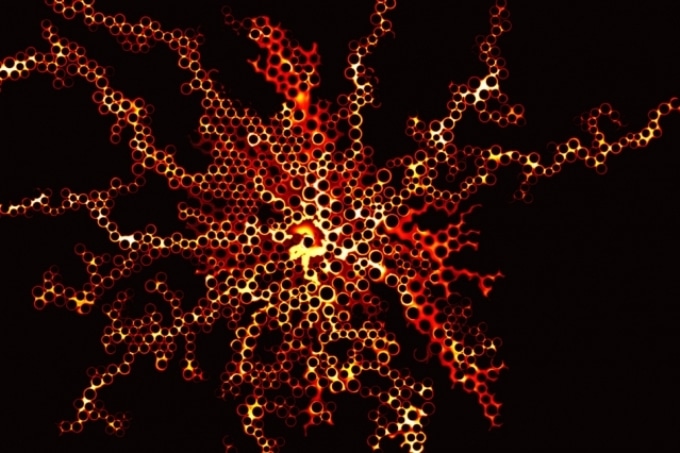Aug 25 2016
 Lab experiments carried out by an MIT and Oxford University team provide detailed information about how a liquid moves through spaces in a porous material, revealing the key role of a characteristic called wettability. (Courtesy of the researchers)
Lab experiments carried out by an MIT and Oxford University team provide detailed information about how a liquid moves through spaces in a porous material, revealing the key role of a characteristic called wettability. (Courtesy of the researchers)
A new approach to restrict man-made greenhouse gases from flowing into the atmosphere has more potential over other approaches. The approach recommends that the gases be captured at chief sources, such as fossil-fuel-burning power plants, and then be injected into deep, water-saturated rocks where they can remain stably trapped for several centuries.
This is one of the examples of fluid-fluid displacement occurring in a porous material, which also applies to a broad range of natural and industrial processes - for instance, when oil recovery is improved by displacing the oil with injected water or when rainwater enters into soil by displacing air.
Recently, a new set of comprehensive lab experiments has offered a fresh perspective into the physics of this phenomenon, under an extraordinary range of conditions.
The outcome of these experiments should assist researchers in understanding the phenomenon behind carbon dioxide flowing through deep saltwater reservoirs, and potentially shed light on similar interactions such as those within fuel cells being used to generate electricity without burning hydrocarbons.
The research findings can be found in the PNAS journal, in a paper by Ruben Juanes, MIT’s ARCO Associate Professor in Energy Studies; Benzhong Zhao, an MIT graduate student; and Chris MacMinn, an associate professor at Oxford University.
A vital characteristic of fluid-fluid displacement is the displacement efficiency, which indicates the amount of pre-existing fluid that can be sent out of the pore space.
High displacement efficiency indicates that a majority of the pre-existing fluid is sent out, which is generally a positive thing especially with oil recovery, for instance, it would mean that additional oil would be captured and less oil would be left behind. However, displacement efficiency is not easy to predict.
Juanes says wettability is a main factor in establishing displacement efficiency. Wettability measures an inclination by the solid to be in contact with one particular fluid than the others. It is a material property.
The team discovered that the displacement of the pre-existing fluid from the pores of the material is more effective when the preference for the injected fluid is stronger - up to a certain extent. However, if the preference for the injected fluid increases past that optimal point, the trend reverses, meaning that the efficiency of the displacement is less.
The detection of the presence of this perfect degree of wettability is one of the vital findings of the new research.
The research was partly motivated by current advances in scanning methods that enables to “directly characterize the wettability of real reservoir rocks under in-situ conditions,” says Zhao.
However just being able to describe the wettability was not enough, he explains. The chief question was “Do we understand the physics of fluid-fluid displacement in a porous medium under different wettability conditions?”
And now, post their comprehensive study, “We do have a fundamental understanding” of the process, Zhao says.
It comes from the design of a novel system that really allowed us to look in detail at what is happening at the pore scale, and in three dimensions.
Chris MacMinn, Associate Professor, Oxford University
In order to clearly describe the physics taking place behind these flows, the team did a number of lab experiments where they used various porous materials with a broad range of wetting properties, and analyzed the reasons behind the variations in the flows.
In natural environments such as oil reservoirs or aquifers, the material’s wettability is predetermined. However, Juanes says, “there are ways you can modify the wettability in the field,” such as by adding precise chemical compounds like surfactants to the injected fluid.
By making it achievable to comprehend exactly what degree of wettability is advantageous for a particular situation, the latest findings “in principle, could be very advantageous” for designing carbon sequestration or improved oil recovery schemes for a particular geological setting.
The same rules apply to certain polymer electrolyte fuel cells, where water vapor condenses at the cathode of a fuel cell and has to travel via a porous membrane. Based on the precise combination of liquid and gas, these flows can be harmful to the fuel cell’s performance, so controlling and estimating the manner these flows function can be crucial in building such cells.
The similar process of gas and liquid interacting in pore spaces is also applicable to the manner in which freshwater aquifers are recharged by rainfall, as the water permeates into the ground and displaces air in the soil. The team highlights that the management of ever-scarcer water resources can further be enhanced through an improved understanding of this process.
This is a very interesting study of pore-scale multiphase fluid flow in two-dimensional micromodels. The advantage of this work is that the authors look in more detail at the mechanisms of wetting and displacement of the fluid in the pores. This is a very important aspect of fluid flow in porous media.
David Weitz, Professor of Physics, Harvard University
The U.S. Department of Energy and the MIT Energy Initiative supported this research.